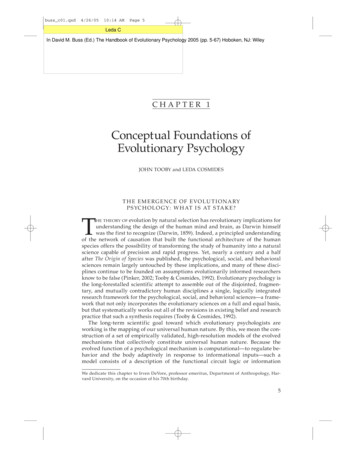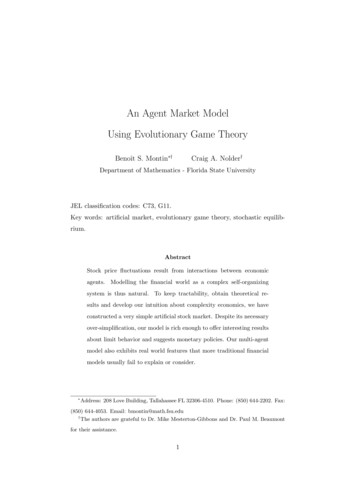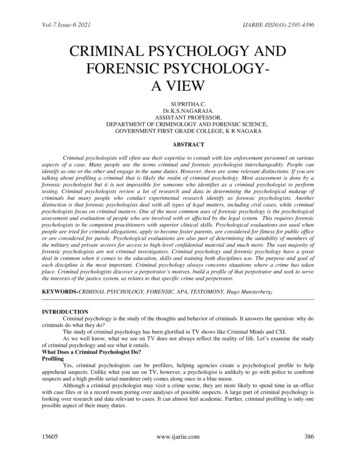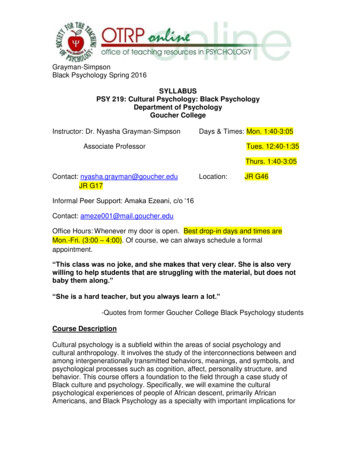
Transcription
Sociobiology and EvolutionaryPsychology
E. O. Wilson: Sociobiology:The new synthesis (1975) Most of the book deals with ants and antsocial behavior– Recall: ants and other social insectsexhibit kin selection Last chapter: Human Sociobiology– Human behavioral traits are adaptations– “Fashions in dress and speech.are for the mostpart adaptive.”– “The requirement for an evolutionary approach toethics is self-evident.” Reground the social sciences on evolutionary biology
Human SociobiologyTraditional sociology and anthropology: account for thefeatures of society in terms of environmental forces“The central tenet of human sociology is that socialbehaviors are shaped by natural selection. In spite ofperturbations due to time and lag, and random effect,those behaviors conferring the highest replacementrate in successive generations are expected to prevailthroughout local populations and hence ultimately toinfluence the statistical distribution of culture on aworldwide basis” (Lumsden and Wilson)
The Sociobiology GambitIf a trait is widespread in human culture, assume that itis a biological adaptationLook for selection forces that would promote this traitPropose (claim) that the trait is such a product ofnatural selection under those forces
Why do we like sugar?Adaptationist account: Our ancestors needed to eat ripe fruit to meet theirnutritional needs. When fruit is ripe, it is loaded with sugars. If our ancestor had a taste for sugar, he or she would bea little more likely to eat ripe fruit. His or her resulting good health would make him or herstronger and more attractive to potential mates. He or she might leave more offspring who, inheritingthis taste for ripe fruit, would be more likely to survive toreproductive age.
Why do we have specific tastesin possible mates? To enhance the survival of our offspring, we want themto have the best genes If a mate is very healthy, vigorous, etc., his or hergenes are probably better As Darwin noted, some animals develop bizarre traitsso as to demonstrate their mate-worthiness
Differential parental investment David Barash: "Males tend to be selected forsalesmanship; females for sales resistance [coyness].” Why? Differential costs:– females can carry limited offspring, face the risks ofpregnancy, increased nutritional needs, etc.– males can, and do, walk away. It is in the female’s interest to up the cost for males toenhance likelihood of long-term support. Males will tryto get away with less, both before and after the birth ofchildren. “It might not just be a cultural fluke that men bringflowers and candies, pay for dinner, and so forth.” (C.George Boeree)
Male aggressionAn expected consequence of the competition for mates“males engage in a great deal of head-butting. But one can't help but noticethat these contests "over" females seldom end in death or even serious injuryin most species. That is because these contests are justthat: contests. They are a matter of displays of virtues, and they usuallyinclude actions that serve as sign stimuli to the opponent that the contest hasended in his favor: surrender signals. Continued aggression is of littleadvantage to either the loser or the winner. Even male rattlesnakes don't biteeach other!“Sociobiologists predict that animals that are poorly equipped for aggressionare unlikely to have developed surrender signals. Man, they say, is one ofthese creatures. But we developed technology, including a technology ofdestruction, and this technology "evolved" much too quickly for our biologicalevolution to provide us with compensating restraints onaggression. Experience tells us that guns are more dangerous than knives,though both are efficient killing machines, because a gun is faster andprovides us with less time to consider our act rationally -- the only restraint leftus.” (C. George Boeree)
Normative Implications? OK, so men are naturally promiscuous– So you cannot blame them for having affairs Aggression among males is natural– Not much we can do about it, so accept it Naturalistic ethics: facts about the natural world,including biology, determine ethical rightness orwrongness “Naturalistic fallacy”?– Claim: cannot drive ought from is
Critiques of Sociobiology Assumes that behaviors are largely under geneticcontrol when at best the evidence is that they areheritable Treats behaviors as atomistic, but in fact most behaviorsare products of complex interactions Human minds (and animal minds) may do a lot morethan calculate the best genetic outcome Minds and culture may both enjoy a large degree ofautonomy from biology
Round 2: EvolutionaryPsychology The heated controversy over sociobiology began todissipate in the late 1980s But a new movement began that called itself“evolutionary psychology” Evolutionary psychology is not just a commitment togiving an evolutionary account of basic cognitivemechanisms It adopts strong commitments to– The modularity of mental processes– A strong adaptationist view of these modules– Adaptations to conditions of the Pleistocene
Evolutionary Psychology“The goal of research in evolutionary psychology is to discoverand understand the design of the human mind. Evolutionarypsychology is an approach to psychology, in which knowledgeand principles from evolutionary biology are put to use inresearch on the structure of the human mind. . . . It is a way ofthinking about psychology that can be applied to any topicwithin it.“In this view, the mind is a set of information-processingmachines that were designed by natural selection to solveadaptive problems faced by our hunter-gatherer ancestors.This way of thinking about the brain, mind, and behavior ischanging how scientists approach old topics, and opening upnew ones.” (Cosmides and Tooby, Evolutionary Psychology:A Primer)
The Mind as a set ofspecialized modulesAll normal human minds reliably develop astandard collection of reasoning andregulatory circuits that are functionallyspecialized and, frequently, domainspecific. These circuits organize the waywe interpret our experiences, inject certainrecurrent concepts and motivations into ourmental life, and provide universal frames ofmeaning that allow us to understand theactions and intentions of others. Beneaththe level of surface variability, all humansshare certain views and assumptions aboutthe nature of the world and human actionby virtue of these human universalreasoning circuits.
General processes vs modularityFrom Descartes, a strong emphasis on the unity of mind Flourens’ opposition to phrenology Opposition to brain localization in 20th century: Lashley,Head, . . . Behaviorists general learning principlesBut cognitive psychology has tended to emphasize the divisionof the mind into specific processors, responsible for differentcognitive processes Memory, language, object recognition, etc. Strategies for dissociation designed to separateprocessing components functionally (and structurally inneuropsychology)
Chomsky’s mental organs proposal“We may usefully think of the language faculty, the numberfaculty, and other ‘mental organs,’ as analogous to the heartor the visual system or the system of motor coordination andplanning. . . . In short, there seems little reason to insist thatthe brain is unique in the biological world, in that it isunstructured and undifferentiated, developing on the basis ofuniform principles of growth or learning—say those of somelearning theory, or some yet-to-be-conceived generalpurpose learning strategy—that are common to all domains”(1980, p. 3).
Fodor’s modularity of mindDistinction between horizontal and vertical modules.Vertical modules: domain-specific mandatory in their operation allow only limited central access to the computations ofthe modules fast, informationally encapsulated have shallow outputs associated with fixed neural architectures exhibit characteristic and specific breakdown patterns exhibit a characteristic pace and sequencing in theirdevelopment
Central CognitionFodor restricted modules to language and sensory processingDenied modularity of central cognition Quinean (degree of confirmation of any belief dependson its relation to any other belief) Isotropic (anything a person knows is relevant todetermining whether to believe a given proposition)So central cognition not informationally encapsulatedFodor’s first law of the non-existence of cognitive scienceOthers (especially evolutionary psychologists) look for modularityall the way inCoupled with view that selection must select for modules
Challenges to Fodorian ModularityEvidence for top-down (as opposed to bottom-up)processingSpeech processing Word recognition based on acoustic and phoneticinformation alone—syntax and semantics have noinfluenceEvidence from shadow speech—people restore thecorrect word despite distortions, which they do notdo when the sound is presented in isolation Controversial case: McGurk Effect
Evolutionary Psychology: Modulesall the way through“We have all these specialized neural circuits because the samemechanism is rarely capable of solving different adaptiveproblems. For example, we all have neural circuitry designed tochoose nutritious food on the basis of taste and smell -- circuitrythat governs our food choice. But imagine a woman who usedthis same neural circuitry to choose a mate. She would choosea strange mate indeed (perhaps a huge chocolate bar?). Tosolve the adaptive problem of finding the right mate, our choicesmust be guided by qualitatively different standards than whenchoosing the right food, or the right habitat. Consequently, thebrain must be composed of a large collection of circuits, withdifferent circuits specialized for solving different problems. Youcan think of each of these specialized circuits as a minicomputer that is dedicated to solving one problem.”
More on Modules (cont.)“Such dedicated mini-computers are sometimes calledmodules. There is, then, a sense in which you can viewthe brain as a collection of dedicated mini-computers -a collection of modules. There must, of course, becircuits whose design is specialized for integrating theoutput of all these dedicated mini-computers to producebehavior. So, more precisely, one can view the brain asa collection of dedicated mini-computers whoseoperations are functionally integrated to producebehavior.” Cosmides and Tooby, EvolutionaryPsychology: A Primer
Five Principles of EvolutionaryPsychology1. The brain is a physical system. It functions as a computer. Its circuits aredesigned to generate behavior that is appropriate to your environmentalcircumstances.2. Our neural circuits were designed by natural selection to solve problemsthat our ancestors faced during our species' evolutionary history.3. Consciousness is just the tip of the iceberg; most of what goes on inyour mind is hidden from you. As a result, your conscious experiencecan mislead you into thinking that our circuitry is simpler that it really is.Most problems that you experience as easy to solve are very difficult tosolve -- they require very complicated neural circuitry4. Different neural circuits are specialized for solving different adaptiveproblems.5. Our modern skulls house a stone age mind.Cosmides and Tooby, Evolutionary Psychology: A Primer
A Stone-age Mind“The key to understanding how the modern mind works is to realize thatits circuits were not designed to solve the day-to-day problems of amodern American -- they were designed to solve the day-to-dayproblems of our hunter-gatherer ancestors. These stone age prioritiesproduced a brain far better at solving some problems than others. Forexample, it is easier for us to deal with small, hunter-gatherer-band sizedgroups of people than with crowds of thousands; it is easier for us tolearn to fear snakes than electric sockets, even though electric socketspose a larger threat than snakes do in most American communities. Inmany cases, our brains are better at solving the kinds of problems ourancestors faced on the African savannahs than they are at solving themore familiar tasks we face in a college classroom or a modern city. Insaying that our modern skulls house a stone age mind, we do not meanto imply that our minds are unsophisticated. Quite the contrary: they arevery sophisticated computers, whose circuits are elegantly designed tosolve the kinds of problems our ancestors routinely faced.”
General Reasoning vs. CheaterDetectionWhich of the following cards do you need to turn overto either confirm or falsify the hypothesis thatif a card has an even number on one side, ithas a vowel on the other?X12XABOnly about 25% of subjects get problems such as thisright
Transformed ProblemWhich of the following cases do you need to considerto see if someone is cheating on the following principleif you charge a purchase on your credit card,you must pay be bill?PersonPaysbillPersondoesn’tpay billPersonchargespurchaseNow 65-80% get the right answerPersondoesn’tcharge
Cheater Detection and SocialContractsTo achieve self-sacrifice (altruism) without kin selection,need reciprocal altruismI’ll scratch your back if you scratch my backUseful to have the payoffs delayedI’ll do this for you now if you agree to do that for mychildren laterDon’t want to make such deals with cheaters, so useful tohave a means of detecting cheatersConclusion: evolution created a cheater detection module!
False Belief TaskWhile Sarah is watching, you and Jimmy put a dollarunder square 112After Sarah leaves, you and Jimmy move the dollar tounder square 2You now ask Jimmy where Sarah will look for thedollar. If Jimmy is 3-4, he will say under square 2
Theory of Mind ModuleWhat Jimmy lacks is referred to as a theory of mind,which he will probably develop around age 5One explanation for autism is that autistics lack a theoryof mindClaim: theory of mind is a module which can appearindependently of othersIt was an evolutionary adaptation
Cognitivism without Modularity?Is there a middle ground between general learningrules and modularity?Mind comprised of distinct processors (carry outdifferent types of information processing) but at a far lower level than modules usually defined constitute a highly interactive system
McGurk EffectSeeing someone say“ga” while hearing “ba”results in perception ofintermediate soundCould be entirely withinlanguage module(motor theory of speechperception)Massaro: rather invokesmore generalprocessing: integrationof information and topdown as well as bottomup processing
Is the brain modular? One of the things neuroscientiststry to do is decompose the braininto different components and linkdifferent activities with thesecomponents It thus seems to be engaged inproducing a modular account ofneural function Example: Broca’s area andlanguage
Decomposition at afiner grain“. . . elementary operations, defined on the basis ofinformation processing analyses of taskperformance, are localized in different regions ofthe brain. Because many such elementaryoperations are involved in any cognitive task, a setof distributed functional areas must be orchestratedin the performance of even simple cognitive tasks. . . A functional area of the brain is not a task area:there is no “tennis forehand area” to be discovered.Likewise, no area of the brain is devoted to a verycomplex function; “attention” or “language” is notlocalized in a particular Brodmann area or lobe.Any task or “function” utilizes a complex anddistributed set of brain areas” (Petersen and Fiez,1993, p. 513).
Hierarchy of Visual Processing Areas32 different visual processingareasApprox. one-third of the possibleinterconnections are realizedMost forward projections arematched by recurrent ones
and principles from evolutionary biology are put to use in research on the structure of the human mind. . . . It is a way of thinking about psychology that can be applied to any topic within it. "In this view, the mind is a set of information-processing machines that were designed by natural selection to solve










